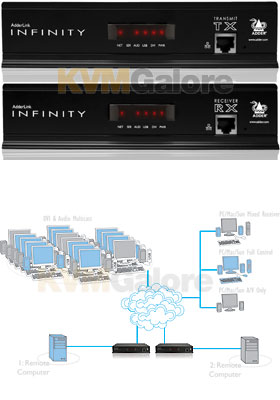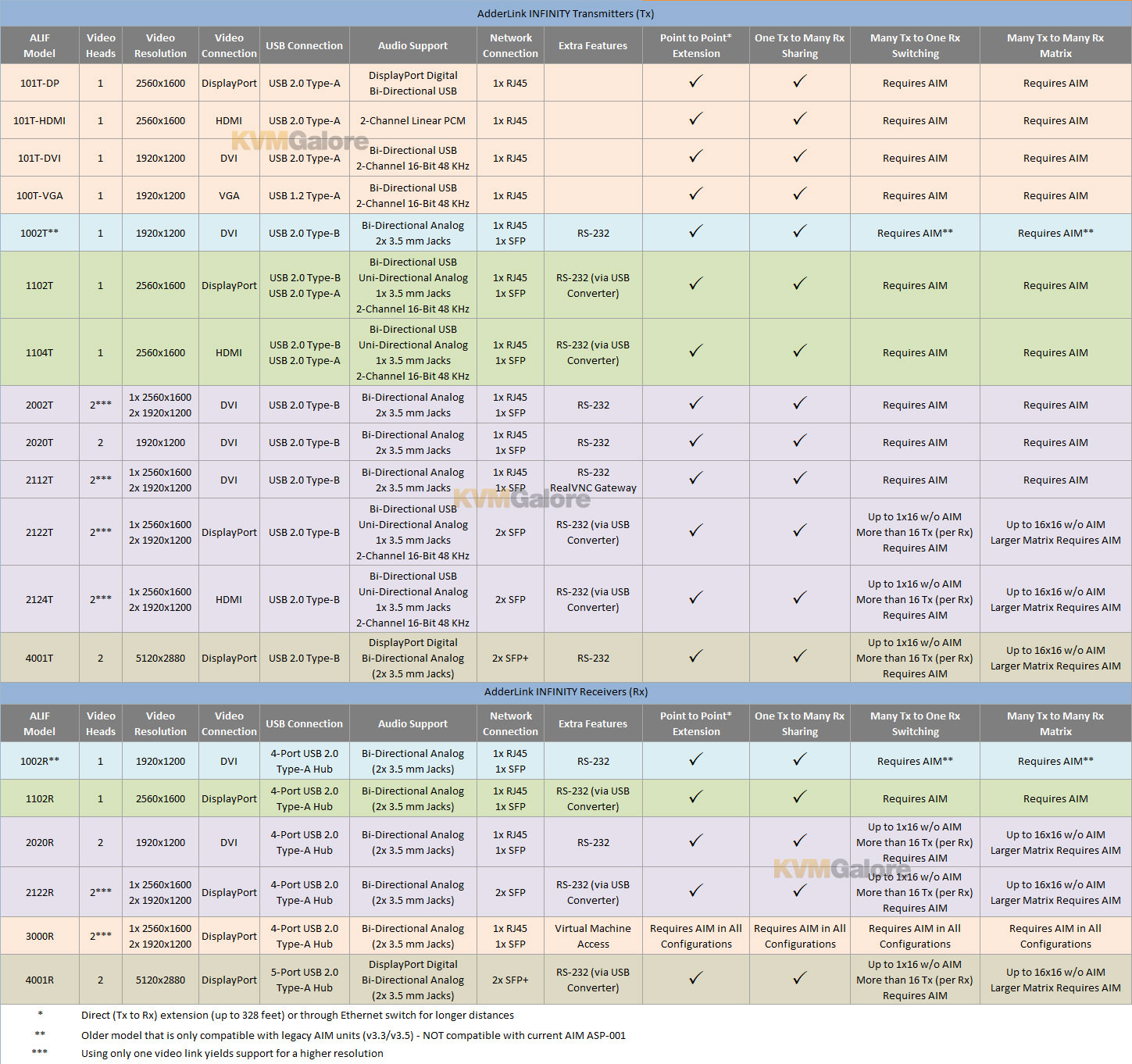Copyright © 2025 KVMGalore® - All rights reserved.

AdderLink INFINITY 1000
Pure digital AV and KVM extension and matrix (digital video - stereo audio - USB 2.0 peripherals) over Ethernet network for KVM and video over IP
Read more below...

1) AdderLink INFINITY 1002, Receiver Model No. ALIF1002R-US  In stock
In stock

2) AdderLink INFINITY 1002, Transmitter Model No. ALIF1002T-US  In stock
In stock
KVM and AV over IP - pure digital audio/video media & KVM extension and matrix solution
digital video - stereo audio - USB 2.0 over IP network

AdderLink INFINITY demonstrates Adder's leading IP capability by delivering fluid interaction with computers as far away as your network can extend.
AdderLink INFINITY represents a major advance in the capabilities of digital extenders and switches. By encoding high quality DVI video, digital audio and USB connections into Internet Protocol (IP) messages, AdderLink INFINITY offers highly advanced and flexible signal switching capabilities.
AdderLink INFINITY allows you to build a flexible infrastructure, the likes of which have not been possible before. Locate computers anywhere you like, share connections to computers, watch the interactions others have with computers, share control, collaborate, switch computers and so on.
With AdderLink INFINITY, distance is finally no barrier to high specification, high performance computing. Furthermore, since all signals are now IP, the most elaborate and yet simple-to-use switching and multicast techniques make possible a great variety of uses.
AdderLink INFINITY units come in two forms: a TX transmitter and an RX receiver. The former attaches to a single computer; the latter to your DVI video monitor, microphone, speakers and up to four USB peripherals. The distance between them is limited only by the size of your Gigabit Ethernet network.
In addition to separating one computer and its peripherals, AdderLink INFINITY promotes sharing. You can arrange for a limitless number of screens and speakers, distributed anywhere across the network, to receive video and audio. You can also switch between any number of transmitter units from a single screen, keyboard and mouse in order to monitor a potentially vast collection of remote systems.
AdderLink INFINITY is also the first device of its kind to allow multicasting across your network. Adder's expertise in IP based KVM solutions also means that you get the very best video quality and fluid USB based interactions with your computer.
Adder's own USB True Emulation technology has also been built into the AdderLink INFINITY, allowing you to connect all HID (Human Interface Devices) as well as storage devices and many other USB device types too. Optimized for both HID and Mass Storage devices, the AdderLink INFINITY uses USB 2.0 technology to deliver reliable and flexible device support.
All units feature browser-based configuration utilities to allow quick and easy set up, from near or far.
Compatibility
All AdderLink INFINITY (ALIF) Transmitter (Tx) and Receiver (Rx) models are fully compatible with one another, as long they are running the latest firmware, subject to feature limitations that only exists on one end or the other.
• Limitation example #1: Tx supports 4K resolution but the Rx only supports HD resolution, so you'd only get HD video on the Receiver unit.
• Limitation example #2: ALIF100T (HD video, full speed USB) connected to ALIF4001R (4K video, high speed and transparent USB) unit, so you'd only get HD video and HID USB support.
Compatibility Notes
1) ALIF1000s are only compatible with legacy AIM units (v3.3/v3.5). The rest of the models are compatible with AIM/ASP as long as they are all running the latest firmware.
2) Only AdderLink INFINITY (ALIF) 2102/2122 and 4001/4021 models can be used in un-managed mode.
3) AdderLink INFINITY (ALIF) 3000s models require AIM - they cannot be used in Point-to-Point topology or in un-managed mode.
Operation Modes
There are two modes in which AdderLink INFINITY system can be deployed:
Un-Managed Mode: Tx and Rx units are deployed in Many-to-One (Switching) or Many-to-Many (Matrix) configurations without the use of AdderLink INFINITY Manager (AIM) server. Only ALIF2102/2122 and ALIF4001/4021 models support Un-Managed mode, restricted to no more than 16 Tx units connected to any given Rx.
Managed Mode: Tx and Rx units are deployed in a network along with AdderLink INFINITY Manager (AIM) server. Many-to-one and many-to-many configurations with multiple users (Rx) being able to switch between as many hosts/Transmitters as they have rights to require the use of AdderLink INFINITY Manager (AIM) server (with the appropriate number of licenses to match the number of end-points).
Topology Deployments
There are four ways to connect AdderLink INFINITY endpoints together:
Point-to-Point (Extension): one Tx to one Rx, via direct cable or via a network switch, with the IP address of the Tx being ‘hard coded' into the Rx unit.
Point-to-Point configuration can be deployed as a direct (Tx to Rx) extension (limited to a distance of 328 feet), or through an Ethernet switch for longer distances.
Point-to-Point configuration does not require to be managed with AIM server.
One-to-Many (Sharing/Reverse KVM): Using multicast techniques, an unlimited number of Receivers can receive video and audio data streams from a single Transmitter unit. A maximum of twelve concurrent USB inputs (via multiple Receiver units) are permitted to a single Transmitter unit.
When there are multiple Receivers connected to the same Transmitter, the Tx does not know (or care) how many Receivers it has connected, 2 or 222. One to many (one Tx to many Rx) is always multicast so the Tx just "gives" the frames to its network switch and the switch has to deliver it to every Rx that needs the frame using IGMP snooping and IGMP querier.
One-to-Many configuration does not require to be managed with AIM server.
Many-to-One (Switching): Multiple Transmitters are connected to one Receiver, so that a user (Rx) can use its console to switch between targets (Tx).
Many-to-One (switching) configuration requires to be managed with AIM server, with the exception of ALIF2102/2122 and ALIF4001/4021 models.
ALIF2102/2122 and ALIF4001/4021 models support Many-to-One (Switching) without the use of AIM server (aka: Un-Managed mode), with a limit of 16 Tx units connected to any given Rx unit (being that the Rx OSD only has 16 entries). There is no limit to the number of Tx and Rx units on the network in Un-Managed mode, however. There could be 100 Transmitters on the network, but each user (Rx) can only connect to 16 of those. So one user could have their own 16 computers and a second user can have their own 16 computers, or the two users can overlap, but they wouldn't be able to connect to all 100 host computers.
Many-to-Many (Matrix): Multiple Transmitters are connected to multiple Receivers, so that many users (Rx) can use their consoles to switch between many targets (Tx).
Many-to-Many (Matrix) configuration requires to be managed with AIM server, with the exception of ALIF2102/2122 and ALIF4001/4021 models.
ALIF2102/2122 and ALIF4001/4021 models support Many-to-Many (Matrix) configuration without the use of AIM server (aka: Un-Managed mode), with a limit of 16 Tx units connected to any given Rx unit (the Rx OSD only has 16 entries). There is no limit to the number of Tx and Rx units on the network in Un-Managed mode, however. There could be 100 Transmitters on the network, but each user (Rx) can only connect to 16 of those. So one user could have their own 16 computers and a second user can have their own 16 computers, or the two users can overlap, but they wouldn't be able to connect to all 100 host computers.










